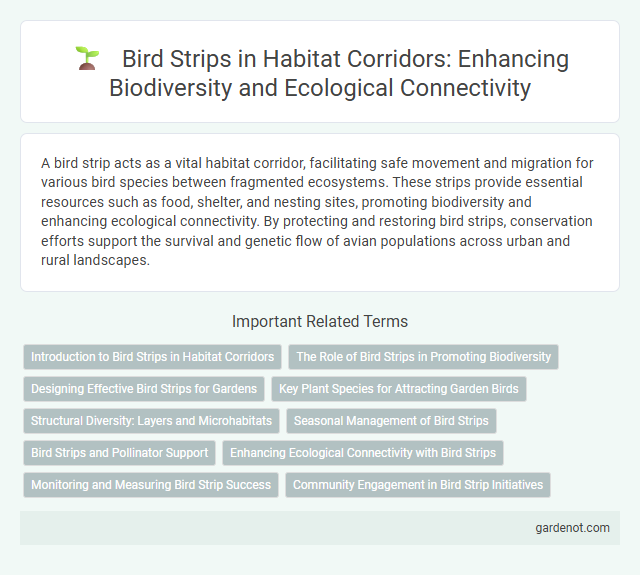A bird strip acts as a vital habitat corridor, facilitating safe movement and migration for various bird species between fragmented ecosystems. These strips provide essential resources such as food, shelter, and nesting sites, promoting biodiversity and enhancing ecological connectivity. By protecting and restoring bird strips, conservation efforts support the survival and genetic flow of avian populations across urban and rural landscapes.
Introduction to Bird Strips in Habitat Corridors
Bird strips serve as narrow vegetation bands within habitat corridors, providing essential stopover sites and foraging resources for migratory and resident bird species. These strips enhance connectivity between fragmented habitats by supporting avian movement and dispersal, promoting biodiversity and ecosystem resilience. Incorporating native plants and structural diversity within bird strips maximizes their ecological benefits and supports a wide range of bird populations.
The Role of Bird Strips in Promoting Biodiversity
Bird strips serve as crucial habitat corridors by connecting fragmented ecosystems, allowing various bird species to safely travel, feed, and breed across agricultural or urban landscapes. These vegetated pathways enhance biodiversity by supporting native flora and fauna, improving pollination, and controlling pests naturally. By maintaining genetic flow between bird populations, bird strips contribute to ecosystem stability and resilience in degraded environments.
Designing Effective Bird Strips for Gardens
Designing effective bird strips for gardens involves incorporating native grasses and wildflowers that provide essential food sources and shelter for local bird species. Strategic placement along garden edges or between planting beds enhances connectivity, allowing birds to safely navigate urban areas and access diverse habitats. Regular maintenance, including seasonal trimming and avoiding pesticides, ensures these strips remain vibrant and supportive of bird biodiversity.
Key Plant Species for Attracting Garden Birds
Key plant species essential for attracting garden birds within habitat corridors include native berry-producing shrubs like Viburnum opulus and Sambucus nigra, which provide vital food resources throughout seasons. Flowering plants such as Pyrethrum and Echinacea offer seeds and shelter, supporting both nesting and foraging behaviors. Incorporating diverse vegetation layers with Crataegus monogyna and Prunus spinosa enhances habitat complexity, promoting occupancy by various bird species.
Structural Diversity: Layers and Microhabitats
A bird strip with high structural diversity incorporates multiple vegetation layers such as grasses, shrubs, and low trees, creating essential microhabitats for various bird species. This vertical complexity supports nesting, foraging, and shelter opportunities, enhancing biodiversity within the habitat corridor. Microhabitats including leaf litter, deadwood, and dense understory promote insect abundance, crucial for insectivorous birds and overall ecological balance.
Seasonal Management of Bird Strips
Seasonal management of bird strips involves adjusting mowing schedules and vegetation height to align with bird nesting and migratory periods, promoting habitat suitability and food availability. Tailored management practices enhance breeding success by protecting nests during critical seasons and supporting insect populations used as food sources. Implementing seasonal interventions in bird strips strengthens habitat corridors, facilitating safe passage and resource access for diverse bird species.
Bird Strips and Pollinator Support
Bird strips enhance habitat corridors by providing essential foraging and nesting sites that support diverse bird populations. These strips often include native flowering plants that attract pollinators, creating a symbiotic environment that benefits both avian species and pollination processes. Integrating bird strips within habitat corridors strengthens ecosystem resilience by promoting biodiversity and facilitating species movement.
Enhancing Ecological Connectivity with Bird Strips
Bird strips serve as critical habitat corridors, enhancing ecological connectivity by linking fragmented landscapes and enabling safe passage for bird species. These vegetated strips provide essential resources such as food, shelter, and nesting sites, promoting biodiversity and facilitating gene flow across isolated habitats. Integrating bird strips into agricultural and urban planning supports avian population resilience and ecosystem health.
Monitoring and Measuring Bird Strip Success
Monitoring bird strips involves using remote sensing technology and regular field surveys to assess vegetation growth, bird species diversity, and habitat quality. Measuring bird strip success relies on metrics such as increased bird population density, nesting success rates, and species richness within the corridor. Data collected through acoustic sensors and GPS tracking assists in evaluating bird movement patterns and habitat connectivity over time.
Community Engagement in Bird Strip Initiatives
Community engagement plays a crucial role in the success of bird strip initiatives by fostering local stewardship and raising awareness about habitat corridors. Collaborative efforts between environmental organizations and residents enhance monitoring and maintenance of these strips, promoting biodiversity. Active participation from schools and community groups boosts education on bird migration patterns and the ecological benefits of bird strips.
Bird strip Infographic

 gardenot.com
gardenot.com